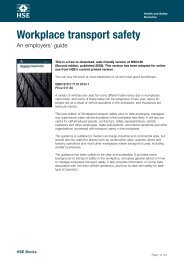Download - Arri
Download - Arri
Download - Arri
Create successful ePaper yourself
Turn your PDF publications into a flip-book with our unique Google optimized e-Paper software.
The sensitivity of the ARRI sensor demonstrator<br />
proved useful for interiors at the<br />
Sistine Chapel, where the production was<br />
forbidden from using any lights. “We were<br />
filming the architecture and the frescos,”<br />
continues Cappellari. “The light in the<br />
chapel was exactly the same as when those<br />
frescos were painted: a very low light that<br />
comes from windows at the top. It was<br />
beautiful to be able to film in that same<br />
light with the 800 ASA ARRI camera.”<br />
For Andreas Berkl, a support specialist from<br />
the ARRI Digital Workflow Team in Munich<br />
who provided on-set support, the shoot was<br />
an invaluable element of the exhaustive R&D<br />
work that ARRI is putting into the new digital<br />
cameras in advance of their launch. “The<br />
system is still under development, so this<br />
was an excellent opportunity to test it in the<br />
The images we<br />
got are absolutely<br />
great and the<br />
camera performed<br />
very well<br />
in extremely low<br />
light conditions.<br />
Norbert Preuss<br />
field,” he says. “We were keen to use the<br />
demonstrator on a real production and we<br />
learned a lot.”<br />
The sensor’s unparalleled combination of<br />
sensitivity and image quality again proved<br />
useful for interiors at St. Peter’s Basilica. “It<br />
was important to have high resolution and<br />
sensitivity for some POV shots of the children<br />
in our story entering the basilica for the first<br />
time,” says Cappellari.<br />
Shooting in Log C mode, the camera crew<br />
made use of ARRI Variable Primes as well<br />
as a range of ARRI Ultra Primes, which<br />
allowed staggeringly sharp images of<br />
Renaissance masterpieces to be captured<br />
in difficult lighting conditions. “Inside the<br />
Sistine Chapel we were wide open on the<br />
lenses and inside St Peter’s it varied between<br />
T4 and T11,” notes Berkl. “We were using a<br />
crane and were panning across the interior,<br />
so we used an Iris Control Unit with the<br />
ARRI Lens Control System to compensate for<br />
exposure changes when we moved from<br />
windows to darker areas.”<br />
Editing the material some time after the<br />
shoot, Cappellari reports that “although<br />
we’re not editing in full resolution, I can<br />
already see the incredible quality of the<br />
pictures from the ARRI sensor; the colours<br />
and the intensity are very strong.” Producer<br />
Norbert Preuss concludes that “it all went<br />
fantastically well. The images we got are<br />
absolutely great and the camera performed<br />
very well in extremely low light conditions.”<br />
Mark Hope-Jones<br />
I had the feeling<br />
that I was working<br />
with a 35mm negative<br />
when I saw<br />
the pictures.<br />
Ciro Cappellari<br />
C a m e r a<br />
19
















